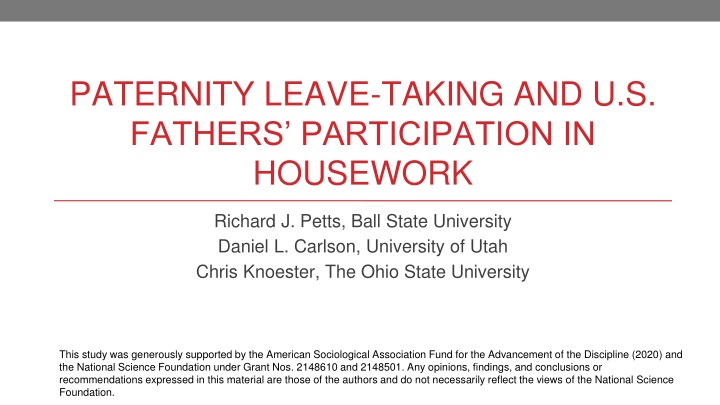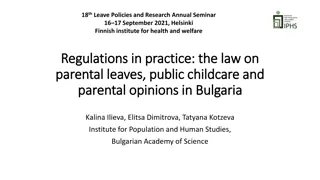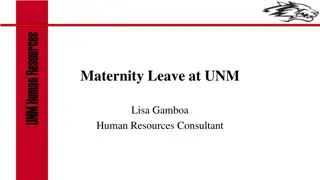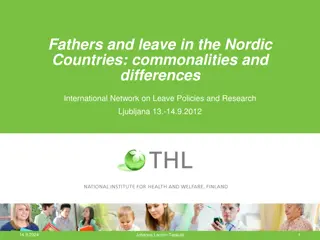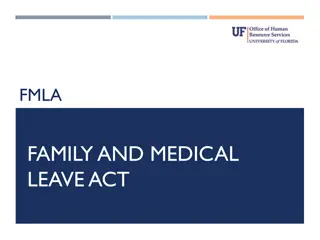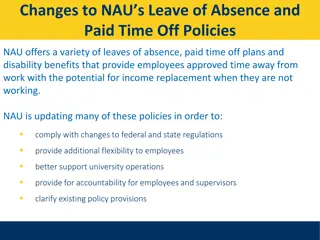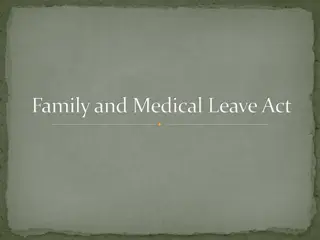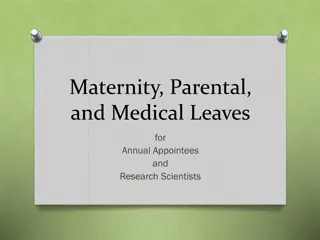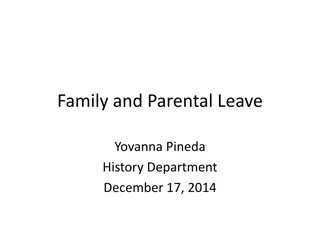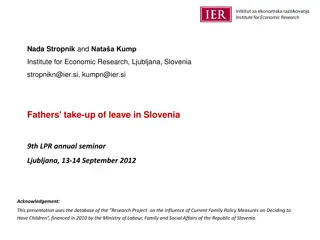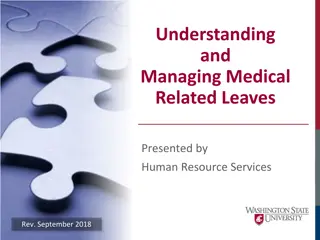Paternity Leave and Fathers' Housework Participation
This study explores the association between paternity leave-taking and U.S. fathers' involvement in housework, highlighting benefits, theories, and evidence. It discusses how paternity leave may impact fathers' engagement in household tasks and the nuances of gender dynamics in caregiving responsibilities.
Uploaded on Mar 06, 2025 | 0 Views
Download Presentation

Please find below an Image/Link to download the presentation.
The content on the website is provided AS IS for your information and personal use only. It may not be sold, licensed, or shared on other websites without obtaining consent from the author.If you encounter any issues during the download, it is possible that the publisher has removed the file from their server.
You are allowed to download the files provided on this website for personal or commercial use, subject to the condition that they are used lawfully. All files are the property of their respective owners.
The content on the website is provided AS IS for your information and personal use only. It may not be sold, licensed, or shared on other websites without obtaining consent from the author.
E N D
Presentation Transcript
PATERNITY LEAVE-TAKING AND U.S. FATHERS PARTICIPATION IN HOUSEWORK Richard J. Petts, Ball State University Daniel L. Carlson, University of Utah Chris Knoester, The Ohio State University This study was generously supported by the American Sociological Association Fund for the Advancement of the Discipline (2020) and the National Science Foundation under Grant Nos. 2148610 and 2148501. Any opinions, findings, and conclusions or recommendations expressed in this material are those of the authors and do not necessarily reflect the views of the National Science Foundation.
Benefits of Paternity Leave Numerous studies suggest that paternity leave-taking provides benefits to families and society including: Increased father involvement in parenting tasks Greater coparenting support from fathers and more stable and satisfying parental relationships Stronger father-child relationships Greater gender equality by promoting more equitable divisions of paid and unpaid labor Less is known about how paternity leave-taking may influence father involvement in housework Extent research largely mixed, suggests weaker influence relative to childcare Research Question: Is paternity leave-taking associated with U.S. fathers shares of, and time spent in, housework?
Why might paternity leave-taking increase fathers housework? Time Availability Theory Leave provides more (dedicated) time at home, facilitating more equitable divisions of domestic labor Socialization/exposure to domestic labor routines Fathers may gain greater awareness of domestic needs Fathers may gain greater confidence in, and experience with, performing housework Could lead to long-term engagement in housework
Evidence on Paternity Leave-Taking and Housework Paternity leave-taking may promote father engagement in housework Consistent with theories and research on leave-taking and father involvement in childcare Housework may be a way for fathers to promote equity in the household as mothers breastfeed and focus more on childcare Some support from the literature (e.g., Datta et al., 2012; Meil, 2013; Meil et al., 2023; Patnaik, 2019) Impact of paternity leave-taking on housework may be limited Expectations for father engagement in housework is less than for childcare Gender gaps in housework larger than childcare (8 vs. 6 hours/week); housework may be viewed as unmasculine Evidence from literature mixed Some find no association (e.g., Schober, 2014) Some find association due to selection effects (e.g., Doucet & McKay, 2020; Lee, 2023) Conflicting evidence regarding length of leave (Almqvist & Duvander, 2014; B nning, 2015; Meil, 2013) and housework tasks (Kotsadam & Finseraas, 2011; Meil, 2013)
Study on Parents Divisions of Labor During COVID-19 (SPDLC) Study objective: Assess changes in parents divisions of labor throughout and after the COVID-19 pandemic, identify factors that drive these changes, and consider the consequences of these changes for gender inequalities and parents well-being. Population: Partnered US parents with at least one biological child in home Data Collection: Online survey administered via Prolific Study Design: Longitudinal Panel with Repeated Cross-Sections Sample: Pooled cross-sectional data from Wave 1 Wave 4 (N = 4,551 unique parents) Focus on: Different-gender partnerships Fathers were working when youngest child was born Youngest child is 3 years old or younger No missing data on key variables N = 1,654
Key Variables: Paternity Leave-Taking Paternity Leave-Taking Defined as taking time off work for the birth of their youngest child, regardless of how leave was taken Length of Paternity Leave Length of Paternity Leave None Less than a week One week Two weeks 3-4 weeks More than a month % 25% 7% 16% 22% 20% 10%
Key Variables: Fathers Participation in Housework Routine housework tasks included in SPDLC: Preparing and cooking meals; Laundry; Shopping for groceries and other household needs; Washing dishes; House cleaning Fathers Shares of Housework Mean of total shares of housework (1 = mother does it all; 3 = shared equally; 5 = father does it all) Fathers Housework Time Total hours spent in housework tasks in week prior to survey (top coded at 95thpercentile)
Other Variables Respondent gender (mother or father) Father age Father has college degree Father race/ethnicity Marital status Number of children Age of youngest child Whether reside with extended family members Work status (mother & father) Essential work status (mother & father) Flexible schedule (mother & father Work from home status (mother & father)
Fathers Shares of Housework, by Paternity Leave- Taking Leave-Taking Length of Leave 42% 42% 40% 40% 38% 38% 36% 36% 34% 34% 32% 32% 30% No leave Less than One week Two weeks 3-4 weeks More than 30% one week a month No Leave Took Leave
Fathers Housework Time, by Paternity Leave-Taking Leave-Taking Length of Leave 11.0 11.0 10.5 10.5 10.0 10.0 9.5 9.5 9.0 9.0 8.5 8.5 8.0 8.0 7.5 7.5 No leave Less than One week Two weeks 3-4 weeks More than No leave Took Leave one week a month
Fathers Shares of Housework by Task and Leave- Taking 45% 40% 35% 30% 25% Cleaning Cooking Dishes Laundry Shopping No leave Took leave
Conclusions Paternity leave-taking is positively associated with U.S. fathers shares of, and time spent in, housework Positive association between paternity leave-taking and fathers housework is similar for most tasks (cooking, cleaning, dishes, laundry) No association between paternity leave-taking and grocery shopping May be due to this task being perceived as more masculine during the pandemic Longer leaves are positively associated with fathers shares of housework, but largely unrelated to fathers time spent in housework Time may become more constrained after returning to work post-leave But exposure to housework during leave (regardless of how much time on leave) may have lasting effects on parents divisions of housework over the long-term
